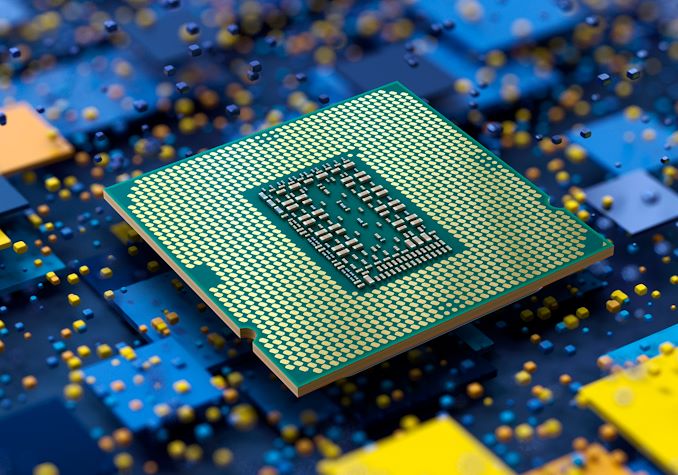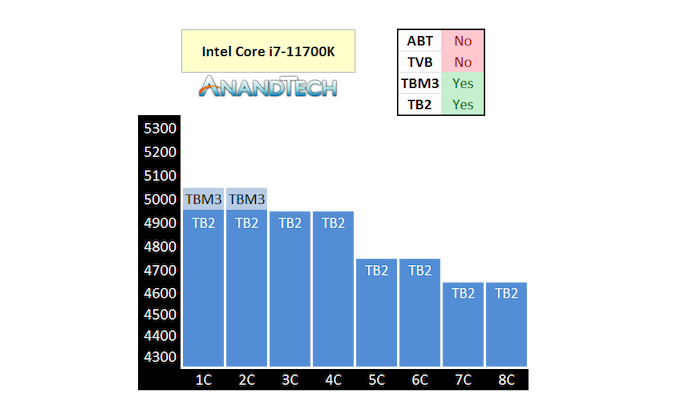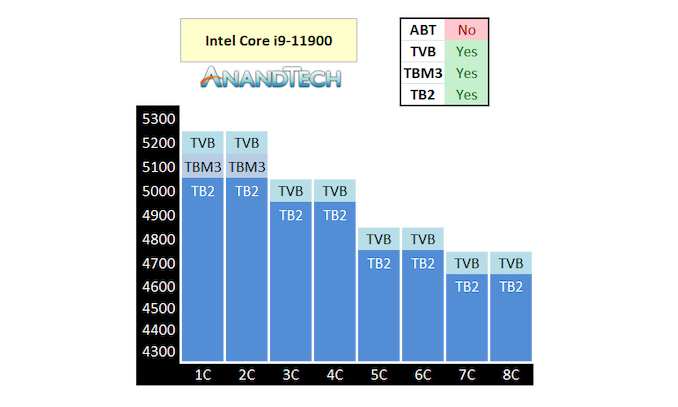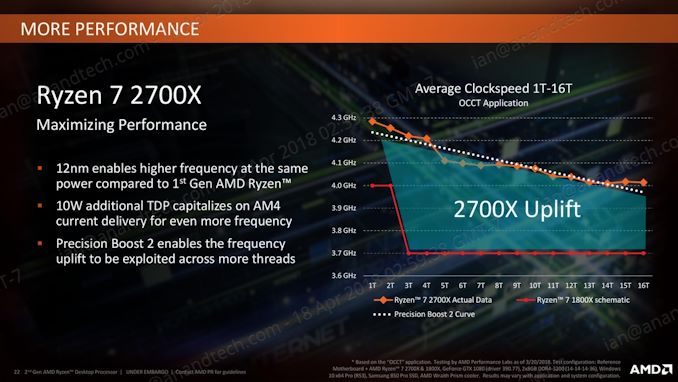Intel’s New Adaptive Boost Technology: Floating Turbo Comes to Rocket Lake
by Dr. Ian Cutress on March 19, 2021 9:00 AM EST
A couple of days after Intel officially announced its 11th Generation Core Rocket Lake, the press received an email about a new feature coming to the platform that wasn’t in our original briefing. The goal of this feature is to provide more performance to users that have good processors, and Intel is calling it Adaptive Boost Technology.
Adaptive Boost Technology is now the fifth frequency metric Intel uses on its high-end enthusiast grade processors, and another element in Intel’s ever complex ‘Turbo’ family of features. Here’s the list, in case we forget one:
| Intel Frequency Levels | ||
| Base Frequency | - | The frequency at which the processor is guaranteed to run under warranty conditions with a power consumption no higher than the TDP rating of the processor. |
| Turbo Boost 2.0 | TB2 | When in a turbo mode, this is the defined frequency the cores will run at. TB2 varies with how many cores are being used. |
| Turbo Boost Max 3.0 | TBM3 'Favored Core' |
When in a turbo mode, for the best cores on the processor (usually one or two), these will get extra frequency when they are the only cores in use. |
| Thermally Velocity Boost | TVB | When in a turbo mode, if the peak thermal temperature detected on the processor is below a given value (70ºC on desktops), then the whole processor will get a frequency boost of +100 MHz. This follows the TB2 frequency tables depending on core loading. |
| Adaptive Boost Technology | ABT 'floating turbo' |
When in a turbo mode, if 3 or more cores are active, the processor will attempt to provide the best frequency within the power budget, regardless of the TB2 frequency table. The limit of this frequency is given by TB2 in 2-core mode. ABT overrides TVB when 3 or more cores are active. |
| *Turbo mode is limited by the turbo power level (PL2) and timing (Tau) of the system. Intel offers recommended guidelines for this, but those guidelines can be overridden (and are routinely ignored) by motherboard manufacturers. Most gaming motherboards will implement an effective ‘infinite’ turbo mode. In this mode, the peak power observed will be the PL2 value. It is worth noting that the 70ºC requirement for TVB is also often ignored, and TVB will be applied whatever the temperature. | ||
Intel provided a slide trying to describe the new ABT, however the diagram is a bit of a mess and doesn’t explain it that well. Here’s the handy AnandTech version.
First up is the Core i7-11700K that AnandTech has already reviewed. This processor has TB2, TBM3, but not TVB or ABT.
The official specifications show that when one to four cores are loaded, when in turbo mode, it will boost to 4.9 GHz. If it is under two cores, the OS will shift the threads onto the favored cores and Turbo Boost Max 3.0 will kick in for 5.0 GHz. More than four core loading will be distributed as above.
On the Core i9-11900, the non-overclocking version, we also get Thermal Velocity Boost which adds another +100 MHz onto every core max turbo, but only if the processor is below 70ºC.
We can see here that the first two cores get both TBM3 (favored core) as well as TVB, which makes those two cores give a bigger jump. In this case, if all eight cores are loaded, the turbo is 4.6 GHz, unless the CPU is under 70ºC, then we get an all-core turbo of 4.7 GHz.
Now move up to the Core i9-11900K or Core i9-11900KF, which are the only two processors with the new floating turbo / Adaptive Boost Technology. Everything beyond two cores changes and TVB no longer applies.
Here we see what looks like a 5.1 GHz all-core turbo, from three cores to eight cores loaded. This is +300 MHz above TVB when all eight cores are loaded. But the reason why I’m calling this a floating turbo is because it is opportunistic.
What this means is that, if all 8 cores are loaded, TB2 means that it will run at 4.7 GHz. If there is power budget and thermal budget, it will attempt 4.8 GHz. If there is more power budget and thermal budget available, it will go to 4.9 GHz, then 5.0 GHz, then 5.1 GHz. The frequency will float as long as it has enough of those budgets to play with, and it will increase/decrease as necessary. This is important as different instructions cause different amounts of power draw and such.
If this sounds familiar, you are not wrong. AMD does the same thing, and they call it Precision Boost 2, and it was introduced in April 2018 with Zen+.
AMD applies its floating turbo to all of its processors – Intel is currently limiting floating turbo to only the Core i9-K and Core i9-KF in Core 11th Gen Rocket Lake.
One of the things that we noticed with AMD however is that this floating turbo does increase power draw, especially with AVX/AVX2 workloads. Intel is likely going to see similar increases in power draw. What might be a small saving grace here is that Intel’s frequency jumps are still limited to full 100 MHz steps, whereas AMD can do it on the 25 MHz boundary. This means that Intel has to manage larger steps, and will likely only cross that boundary if it knows it can be maintained for a fixed amount of time. It will be interesting to see if Intel gives the user the ability to change those entry/exit points for Adaptive Boost Technology.
The other difference is that for now, ABT on Intel is disabled by default. Users will have to enable it in their BIOSes to take advantage. On that scale, I suspect most won't, simply because most do not enter the BIOS. Enthusiasts might, however they might also decide to overclock, which makes ABT moot. The other alternative is that motherboard vendors will enable it by default anyway, simply because Intel says it is within specfication.
The Final Word
It’s a bit odd that Intel decided to talk about this feature two days after the official Rocket Lake announcement, to the point that BIOSes enabling ABT are only being distributed now (this doesn’t affect our Core i7-11700K review). This indicates that perhaps the feature wasn’t ready in time for the announcement, or even, ready to go and Intel was still debating whether to actually make it a feature? Then again, all of the Z590 motherboards that we’ve seen seem overbuilt for this generation of processors – Z590 starts at $175, which used to be a mid-market price, so something like ABT should be ready to go. It does make me wonder if ABT is applicable for B560 motherboards, or if it will be a Z590 only feature. Intel has stated that ABT is within warranty and not considered overclocking.
There will be some users who are already familiar with Multi-Core Enhancement / Multi-Core Turbo. This is a feature from some motherboard vendors have, and often enable at default, which lets a processor reach an all-core turbo equal to the single core turbo. That is somewhat similar to ABT, but that was more of a fixed frequency, whereas ABT is a floating turbo design. That being said, some motherboard vendors might still have Multi-Core Enhancement as part of their design anyway, bypassing ABT.
Overall, it’s a performance plus. It makes sense for the users that can also manage the thermals. AMD's implementation allowed it to get additional performance when it moved to TSMC’s 7nm. I have a feeling that Intel will have to shift to a new manufacturing node to get the best out of ABT, and we might see the feature on the more mainstream CPUs.














123 Comments
View All Comments
Spunjji - Monday, March 22, 2021 - link
"For those of us who want to run AVX-512 fast"Good to know there is a CPU out there for you and the little mouse that lives in your pocket.
eastcoast_pete - Saturday, March 20, 2021 - link
Don't forget that right now, AVX512 is the key remaining differentiator Intel has vs. Zen3. If Intel is smart, they'll promote the hell out of AVX512 use, provide programming tools for it etc. For pretty much all other use scenarios, Zen3 has them beat for now, and Intel knows that.Qasar - Saturday, March 20, 2021 - link
even then avx512 is pointless, what programs, OTHER then benchmarks use it ? but at the same time, IF amd also supported it, then maybe more programs would then use it, i have also read that amd doesnt support it cause they feel the trade offs of implementing it, IE : increased power usage, increased temps, lower clocks, just are not worth it right now.smilingcrow - Saturday, March 20, 2021 - link
The issue isn't the power consumption as you can use a larger AVX offset. That way you manage the maximum Watts but still benefit from the superior power efficiency of AVX-512.But the lack of software support and the extra die space mitigates against it.
Although I recently bought some DAW software that supports it.
Qasar - Saturday, March 20, 2021 - link
" as you can use a larger AVX offset. " then what would be the point ?" superior power efficiency of AVX-512. " going by how much power avx 512 uses, it doesnt seem like its very power efficient :-)
GeoffreyA - Sunday, March 21, 2021 - link
I was hoping AMD would boycott AVX512, and be firm about why, but now that they're implementing it---in Zen 4?---it will sadly remain on CPUs for a long time, whether much used or not.Beaver M. - Monday, March 22, 2021 - link
"Dont implement new instruction sets, because no software can use them".You have any idea where we would be if people would listen to such nonsense?
LiKenun - Saturday, March 20, 2021 - link
First they gotta sell AVX-512 to the developers. I see AVX-512 and I think to myself… this only works on Intel, so if I optimize for it, it takes away limited resources that I could dedicate to code that works for 100% of the market. Depending on the customer the software is for (and Intel is found in a lot of business environments), it may or may not be worth it.whatthe123 - Sunday, March 21, 2021 - link
your compiler can handle an avx512 build for you. the onus is on intel getting avx512 into people's hands without crazy high power draw, hand optimizing for avx512 isn't even part of the equation at this point unless you're writing software for personal use/enterprise.Carmen00 - Sunday, March 21, 2021 - link
AVX-512 can only be used for algorithms that have some non-trivial SIMD (single instruction, multiple data) component. It's not just a case of saying "change the compilers" or "educate the developers". If the algorithm isn't amenable to SIMD (and FYI, many many many algorithms aren't), then AVX-512 is just not applicable. And even when an algorithm DOES have a SIMD alternative, that is often more difficult to understand, debug, and maintain. Since SIMD algorithms and single-threaded algorithms can be quite different, there's no way for compilers to go automatically from one to the other, except in the most trivial of cases.The way I see it, the situation is only getting worse for Intel in this area because there's already a far better SIMD device in most computers - it's called a GPU. One of the big barriers to using that is that the programming model is different and the copy-time might offset any advantage gained. But if those are addressed ... and, by the way, AMD and others are addressing those ... then why would anyone want to use a janky SIMD-lite instead?